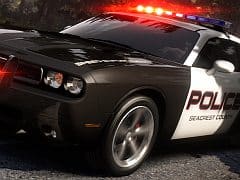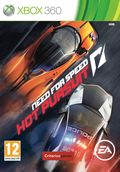You can trust VideoGamer. Our team of gaming experts spend hours testing and reviewing the latest games, to ensure you're reading the most comprehensive guide possible. Rest assured, all imagery and advice is unique and original. Check out how we test and review games here
It was always going to be hard for Criterion’s Need for Speed to break free from the Burnout mould. While Hot Pursuit isn’t simply Burnout Paradise with licensed vehicles, it feels far closer to that series than it does the likes of Undercover, Most Wanted and Underground. Gone are the series’ trademark car customisations and attempts at storytelling, now replaced by a fairly straightforward career that focuses on one thing: speed. Driving in cop cars or high performance luxury vehicles might be what draws people in, but it’s the speed they’ll remember.
Story is nowhere to be seen, meaning you’re thrown straight into the action via the game’s map. The entirety of Seacrest County is before you; a place of huge interconnecting freeways, off-road shortcuts and the landscape variation of an entire continent. While you’re able to freely drive around, Hot Pursuit isn’t really an open-world game – its events take place in closed-off portions of Seacrest’s roadways.
At any point you can choose to play as a Cop or a Racer, with the two careers running side by side on the game’s overview screen – Cops earn Bounty which counts towards Rank, while Racers’ Bounty pumps up their Wanted level.
As a Racer you’ll be taking part in Hot Pursuit, Race and Time Trial events. While Race events pit you against other drivers, often with restrictions on vehicles, you’re never going to have to worry about cops – it’s just a straight up charge to the finish line. Hot Pursuit is essentially a race, but with cops trying to shut it down by taking out you and your rivals. Time Trial is what you’d expect – you against the clock – but with the added hindrance of traffic and pesky cops on your tail.
On the reverse side, the Seacrest County Police Department get to hunt down racers in Hot Pursuit mode, disabling vehicles with brute force and well-timed use of weapons; Interceptor events have no fixed route, but task you with stopping the suspect; and Rapid Response is the SCPD version of time trial, but with penalties for causing damage to public property.
If you’re worried the talk of weapons means your cars are going to have machine guns mounted on the bonnet, think again. Racers and Cops each have four tools at their disposal – although the game varies your load-out in each event – that give you a helping hand when trying to accomplish your goals. Racers can use a Jammer to block SCPD communications; Spike Strips deploy behind you and can temporarily slow down pursuers; EMP blasts can be targeted at rivals and cops, causing damage and throwing them off during corners; while Turbo provides a rocket fuelled injection of speed.
The SCPD share the Spike Strip and EMP, but also get the ability to call in Road Blocks or a Helicopter to lay down spikes ahead of racers. All these weapons can be levelled up as your progress through the careers, and you’ve also got a basic nitrous boost. As a Racer your boost meter is filled by driving dangerously or drifting, while Cops only get it from driving fast or drifting.
Without a single slow car in the game you’re always going to be travelling at breakneck speeds, with only fractions of a second available to make decisions. Indecision is a real killer as you just don’t have time when faced with an oncoming car while travelling at 180mph. Thankfully there’s never traffic jam levels of cars on the roads, but there’s just enough to cause problems if you’re not concentrating 100 per cent on the road – which is easy to do when you’ve got your opponents to think about.
Hot Pursuit is an arcade racer through and through, with a definite touch of OutRun and Ridge Racer in its handling. This is most evident when cornering, with cars gripping the track and sliding around as if Scalextric models. There’s really nothing to fault with regard to the handling model, with the cars never feeling anything but entirely under your control even when hurtling along at top speed while deploying a spike strip. And things just get even slicker when the tarmac is covered in a layer of water, making powersliding that bit more satisfying – so much so that I’d have been happy if the entire game was set within a storm.
Built into career mode is Autolog, a kind of social network for Hot Pursuit. The game tracks the achievements of your friends and lets you know what times they’ve set, giving you challenges to try and beat. You can add text to a Wall, egging friends on to try and beat your times or simply post up pictures of your favourite parts of the county – although on-the-fly pics snapped mid-race are sadly not HD, with the pause menu photo mode being the only way to take lovely crisp pictures.
While Autolog is excellent, and something I wish all racing games had in some shape or form, it’s not quite as revolutionary as EA and Criterion seem to want us to think. For one, a lot of what is does appeared in Activision and Bizarre Creations’ Blur earlier in the year – which also supported Facebook and Twitter, which Hot Pursuit doesn’t.
With a definite cops and robbers vibe to the gameplay, multiplayer in Hot Pursuit is always great fun. There is straight up racing, but the game is at its best when you’ve got two cops trying to take down six racers. I was slightly concerned that weapons would cause a kind of Blue Shell situation, unbalancing multiplayer races, but that has thankfully been avoided. This is largely down to most weapons being avoidable in some way, but also due to none of them being ridiculously overpowered.
Seacrest County is a beautiful location for driving the world’s most powerful cars, with the routes showcasing some stunning vistas and an excellent variety of environments. Weather effects and changes in lighting (there’s day and night here) help make the world feel believable too, while the cars themselves are all modelled to the level we’ve come to expect from games of this generation. Crashes are less destructive than those in Burnout, but they’re still often quite spectacular, rife with car damage and plenty of barrel rolls.
What lets Hot Pursuit down is its relative simplicity and the lack of things to do. Missing almost completely is customisation, which has been a staple of the Need for Speed series for a long time – all you can do here is change the colour of your vehicle. There’s also none of the collectibles and side objectives that made Burnout Paradise such a time sink. Yes, this isn’t a Burnout game, but it doesn’t feel entirely like Need for Speed either. The free roaming mode feels somewhat pointless at the moment, with absolutely nothing to collect, no stunt locations – nothing. Even if DLC includes side objectives, the county itself isn’t as intricate as that in Paradise, made almost entirely of long freeways.
Despite feeling like a fusion of Need for Speed and Burnout, Hot Pursuit is still the most exciting title the franchise has seen in a long time. The core driving is never anything but exhilarating, visually it’s almost flawless and the Autolog features are genre leading. There’s still something missing, though. While the high-speed pursuits are up there with the best gaming experiences of the year, the game needs more than that: car tuning, a resemblance of a story – complete with cheesy acting – and a reason to explore the open world. Ultimately, Hot Pursuit could have done with a bit more Need for Speed and Burnout.
Need for Speed Hot Pursuit
- Platform(s): PC, PlayStation 3, Wii, Xbox 360
- Genre(s): Racing

/https://oimg.videogamer.com/images/b760/nfs_hot_pursuit_29.jpg)
/https://oimg.videogamer.com/images/65da/nfs_hot_pursuit_15.jpg)






